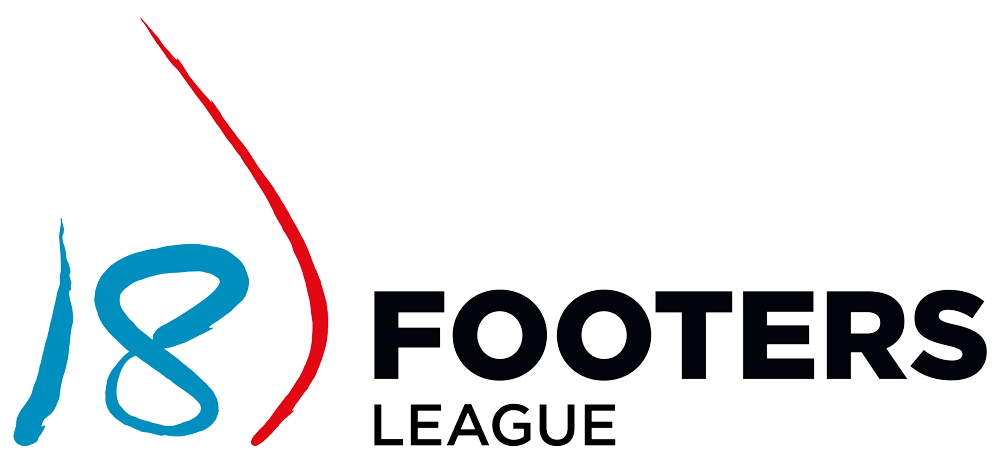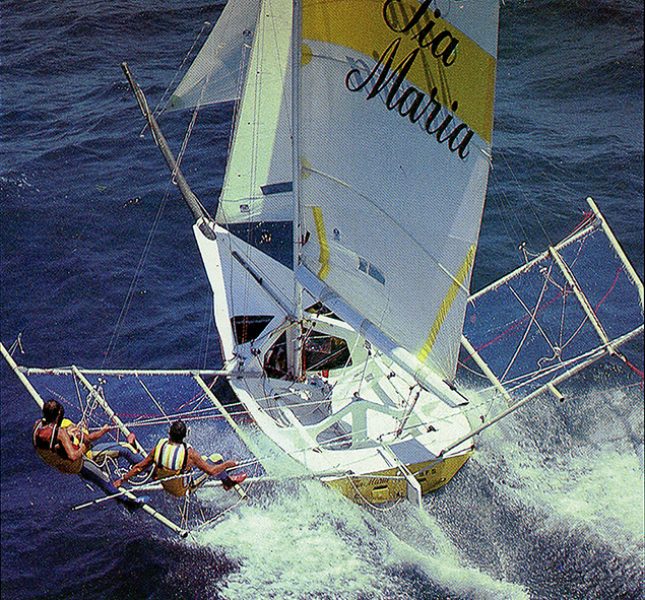The 1970s is regarded as the ‘golden era’ of 18 footer racing with large fleet and champion competitors competing each week on Sydney Harbour, strong fleets in New Zealand and Queensland and emerging fleets in Western Australia, UK and the USA.
What followed during the 1980s was a mixture of incredible innovations by highly-talented individuals but it also affected costs and led to a significant reduction in all fleet sizes.
Despite the problems, it’s important that we don’t let the ‘negatives’ override the wonderful accomplishments and progress made within the evolutionary iconic 18 footer class during the 80s.
Actually, the first stage of the innovative process began during the latter half of the 1970s when New Zealand’s Russell Bowler introduced modern technology into hull construction and Australian competitors began to introduce the use of ‘wings’ to the sides of their hulls.
New Zealand’s Russell Bowler had been progressing his design ideas over the previous 3 or 4 seasons and introduced his latest design on Benson & Hedges at the 1977 World Championship. The boat was a very small, light, round-bilged hull which pioneered a polystyrene core sandwiched by a very thin fiberglass laminate, and was reportedly one-third lighter than the plywood NZ boats.
Bowler’s new structure proved stiff and fast and it wasn’t surprising that a similar method was adopted by the Australians for the following season to replace the lightweight moulded-timber construction.
Murray was impressed, but for the following season decided to use Nomex honeycomb paper as the core material, covered by Kevlar skins in a female mould. The hull weight was about 160 lbs, with all the fittings.
Murray told Australia’s top yachting journalist, Bob Ross, in an interview that he had rejected polystyrene foam and Klegecell and settled on Nomex honeycomb paper (which had been developed in the American space program) for the core material of his new 1977-78 Color 7 hull.
Together with boat builder John McConaghy, Murray developed a construction process in which they “laminated the hull in a female mould, with the Nomex sandwiched within Kevlar skins, and fitted it with an alloy-frame suspension system to support the centrecase and relieve the rig loads.”
Later Color 7 hulls were built from Nomex honeycomb paper sandwiched between skins of carbon fibre and S-glass. Murray believed this made the hull twice as strong as the Kevlar-skinned previous hull.
The ‘revolutionary’ hull weighed about 160lbs, with all the fittings, and was said to be 40lbs lighter than KB (Color 7’s main competitor), which was constructed from a Kevlar/Klegecell combination.
The next great change in 18 footer equipment came at the 1979-80 Australian Championship in Perth when Western Australia’s Richard Court introduced a sliding frame to increase leverage on his Court Yachts skiff.
In 1974-75, Stephen Kulmar (Miles Furniture) and later John Winning (Pacific Harbour Fiji) had previously used small ‘fixed’ rails on the side of their hulls, but the new method was so successful for Court that the top teams at the 1980 Giltinan World Championship in Auckland used hinged ‘wings’ for the leeward one, raised by a wire joining it to the windward one.
According to Andrew Buckland, during the earlier years of the 80s, there was little development in hull design, but the technological improvements continued at a frantic pace with the leading boats all being constructed from pre-impregnated carbon over Nomex.
In the 1982-83 season, the innovative Julian Bethwaite introduced his latest design, sponsored by Prime Computers, which was a stretched version of the two-person Tasar dinghy, designed by his father Frank Bethwaite.
The boat was built in a fibreglass foam sandwich and had only two rigs as it had been intended to become the first ever two-handed 18ft skiff. Unfortunately for Bethwaite, rules required a minimum of three crew members in championship and many club events so the boat had to race mainly with a light-weight third hand.
Another significant innovation occurred at the end of the 1982-83 season when Andrew Buckland, who was sailing on the 1983 world champion Tia Maria, observed that the boat had sailed all season without pulling the spinnaker pole back from the forestay and that all the systems could be simplified by eliminating the spinnaker pole and setting the spinnaker from a fixed or retractable bowsprit.
The concept quickly evolved to a sail (asymmetrical spinnaker) with a loose luff much more like a conventional spinnaker than the old jib style asymmetric sails.
The 1983-84 season honours were shared by Peter Sorensen’s Tia Maria and Trevor Barnabas’ Chesty Bond. Both boats were built from a carbon fibre and Nomex honeycomb paper sandwich, but the Tia Maria hull was baked in an autoclave at extremely high temperature, which Sorensen claimed made the boat stronger.
That season and the 1984 Giltinan World Championship were both history-making. It was the first time two-handed 18ft skiffs were allowed to race and Julian Bethwaite, the designer, builder and skipper created even more history when his two-handed Prime Computer (MkII) won Race 5 of the Giltinan World Championship.
According to Bethwaite, the hull was built of strip-planked balsa, edge-glued with epoxy over a male mould. The Prime Computer hull, with wings, weighed around 150lbs, which was 50lbs less than the lightest of the then three-handers.
The success of Prime Computer (Mk II) led to a new (Mk III) being built for the 1984-85 season. This hull was built from strip-planked balsa, sealed with S glass. According to her Bethwaite, “it was ridiculously light (45kgs, not including fittings and wings), and had 1mm aircraft ply frames.”
Three other new boats built for 1984-85 were labelled ‘pencils’ because of their narrow 4.3ft waterline beam and 21.3ft wingtip beam, and created much discussion because of their “sailability”. The design rationale was based on the premise that two pairs of hands were never enough, but the lighter displacement afforded by the two-hander concept was certainly an advantage.
The Australian 18 Footers League staged a unique promotional 18ft skiff event in January 1985 to celebrate its 50th anniversary which captured the imagination of supporters and produced one of the most amazing 18 footer races ever seen.
The event was the seven-race Gold Cup series highlighted by the final race of the, named the ‘Ocean Challenge’, which was a 26-mile race starting on the Pittwater side of Palm Beach, and finishing east of the Sydney Opera House.
A large crowd watched an aerial display before the skiffs sailed around the headland, set their spinnakers and headed south in a perfect 15-18 knots North-East wind. The leading teams covered the journey down the coast (on their 26ft wing span) at an average speed of around 20 knots.
A large spectator fleet met the skiffs at the Heads to Sydney Harbour, and they weren’t disappointed when the two leaders, Chesty Bond and Tia Maria, arrived with just a couple of boat-lengths separating them. With media helicopters hovering above, the two teams produced a magnificent spinnaker race down the harbour before Chesty Bond finally crossed the finish line just one second ahead of Tia Maria.
Rob Brown had been involved with Australia II’s America’s Cup campaign and his new hull’s design came as a result of the experience.
In his own words, Brown recalled: “For the 1984-85 season, I decided to do my own design once again, after spending so much time with the Americas Cup and what we achieved over there with our attention to detail, innovation and persistent focus for improvement in all areas of our campaign.”
“I got really close to Peter Van Oossananen, (who tank tested Australia II in Holland and did all the design development work on the keel for Ben Lexcen. He also ran our telemetry system, monitoring our performance each day we sailed.”
“I travelled to Holland to test a ½ scale 18’ skiff model of my design and the introduction of the hollow in the transom of hull shape. The hollow feature was a break-through in 18’ skiff design. It involved having a hollow section in the last one-third of the hull, which generated an upward force on the hull. The performance gain was quite staggering. As the boat speed increased out of a tack, a force of 45-50kgs was generated lifting the transom vertically up.”
“The boat was built from a combination of strip plank balsa and carbon fibre.”
The 1985 Worlds, which was sailed on Brisbane’s Waterloo Bay, could also be described as a ‘wing war’ as the 1980 introduction of ‘wings’ to the hulls had grown to extreme wingtip-to-wingtip width.
Prior to leaving Sydney, most teams lengthened their wings to accommodate the anticipated winds as well as the ‘less tactical’ nature of the course. According to Rob Brown, “The fleet started the regatta with wings at 26ft and by the last heat of the worlds having the widest wings on any skiff in history, 32ft from wing to wing.”
“After racing each day, we would pack the boat up and load everything on the trailer and head to the workshop to add another metre or so to the wings and every other control line and have it ready to go by the next day, which also tested the engineering limits of the hull, foils, sails and equipment to its absolute limit.”
As a result of the ‘wing war’, the Sydney clubs quickly decided to introduce a ‘wing span’ limit of 6.8m/22ft, calculated 3.4m/11ft from the centreline of the boat, to prevent any possible bending of the rules with a sliding frame.
The next innovation came when Trevor Barnabas built a new Iain Murray-designed Chesty Bond which featured a one-piece deck that ran through to the bow. Then, when the World Championship was staged on the Swan River in Perth in 1987, Barnabas and Chesty Bond created a new record for a single mast height on an 18 footer.
With many classes contesting their nationals on the same area, race times were allotted to the host clubs to prevent congestion and the 18s were allocated four early morning start times. Barnabas believed he would need a big mast to take full advantage of the expected light morning winds and Chesty Bond carried a #1 mast which was an incredible 45ft above the waterline.
The ongoing cost and reduced fleet size problems sent the League looking for a low-cost alternative to the boats of the 1980s and Julian Bethwaite was encouraged to design a new boat, which he called a B18.
Five were built, from S-glass and Kevlar over PVC foam, for the 1988-89 season, and were fitted with just one rig. Four sponsors were secured for the new B18s, which cost approx. one-third that of an existing-style custom boat.
While there were problems during the decade, it was an exceptional period of innovation.
Frank Quealey
Australian 18 Footers League Ltd

